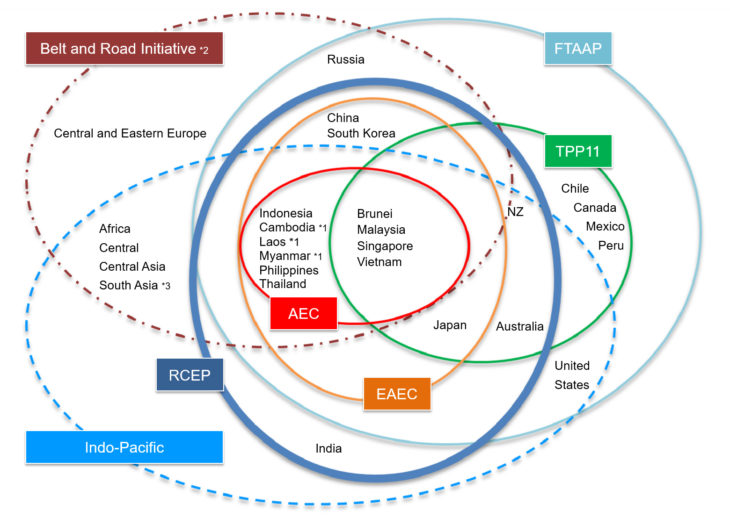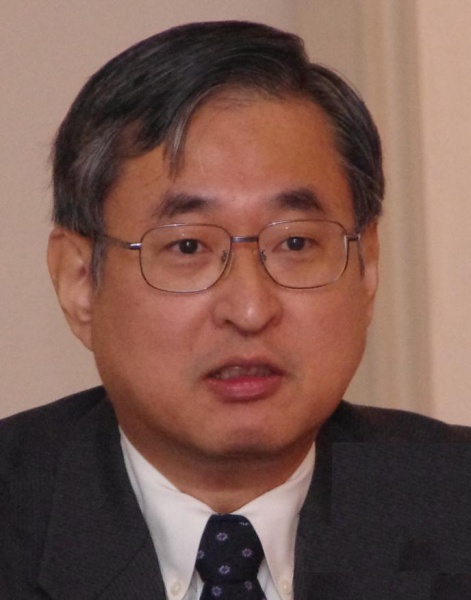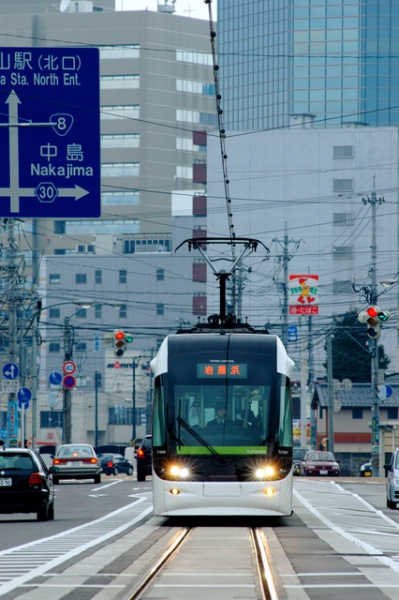Prospects for the RCEP Negotiations: Protecting the Liberal Economic Order
Key Points:
- Diverse frameworks are competing to lead the regional order
- RCEP increasingly important due to US withdrawal from the TPP
- Concerns that Belt and Road Initiative (BRI) is inconsistent with the liberal order

Prof. Oba Mie, Tokyo University of Science
The Regional Comprehensive Economic Partnership (RCEP) is an initiative targeting aspects of regional economic integration between the Association of South-East Asian Nations (ASEAN) and the six countries that already have free trade agreements (FTA) with the ASEAN (Japan, China, Korea, India, Australia and New Zealand). Formally declared open in 2012, the ongoing negotiations aim to establish the rules for eighteen areas including goods, services, investment, rules of origin, intellectual property, competition, and dispute settlement.
One of the points in favor of the RCEP is that the members include China and India as well as all ten ASEAN countries. Only four of the ASEAN countries participate in the Trans-Pacific Partnership (TPP) or its replacement the TPP-11 agreed in March this year after the withdrawal of the United States, while China and India are not members. Compared to the TPP, the RCEP is an important attempt to further comprehensive integration focused on Asia.
Advancing the RCEP negotiations is politically important in the sense of the participating countries showing their support for the liberal economic order in defiance of the protectionist tendencies feared worldwide, and their willingness to move toward further implementation. The protectionist trade and commerce policies of the United States under the Trump administration have jolted the liberal economic order as trade friction has erupted with China and other countries. Total gross domestic product (GDP) for the RCEP countries is above 20 trillion yen, accounting for one-third of the world, so an RCEP agreement will definitely have a not insignificant ripple effect on global trends.
The agreement also aims for wide-area regional economic integration centered on the ASEAN. In December 2015, the ASEAN announced the establishment of the ASEAN Community with the ASEAN Economic Community (AEC) as one of its pillars. With the deepening of economic integration and cooperation by forming a single market and production base among its stated aims, the AEC initiative plans to strengthen economic cooperation with countries external to the region while pressing for further development of the ASEAN economy. For Japan and countries external to the region, participation in the RCEP negotiations sends a significant political message in favor of maintaining and strengthening ASEAN centrality.
Such is the importance of the RCEP, but the negotiations are navigating tricky waters. A statement adopted at the RCEP summit meeting in November last year confirmed that efforts to reach a settlement in 2018 will be intensified, but the countries are definitely not united.
Basically, the ASEAN countries aspire to a swift conclusion to the negotiations from the perspective of focusing on ASEAN centrality. However, India’s extremely negative position on reducing tariffs has become a major stumbling block for the negotiations. On the other hand, the ASEAN countries are unmotivated by India’s request for a “balanced outcome” including services and investment as well as the trade in goods. Australia and New Zealand will not break with the principle of reaching advanced and comprehensive liberalization despite the pronounced differences in degrees of enthusiasm among the other participating nations.
As the diagram indicates, there are a number of proposed schemes and frameworks centered on Asia. The situation is a complex one encompassing negotiations toward implementation, or cooperation within frameworks that have already been implemented. The context is strategic political competition around issues such as the aims of shaping a new regional order, what rules and standards will apply to it, and under which country’s leadership. One attempt among several competing efforts, RCEP has a particularly deep connection with the TPP and the TPP-11.
Up to this point, the RCEP and TPP have motivated each other to make progress with the negotiations. Aiming for advanced and comprehensive liberalization, TPP is an attempt to shape an Asia-Pacific order that conforms to the liberal economic order. The RCEP framework basically conforms to the liberal economic order, but it aims for somewhat loose liberalization and rule-making on account of the diverse situations in the Asian countries. So the two frameworks are hardly perfectly coordinated. However, the US withdrawal has had a major negative impact on the TPP and has also shaken the liberal economic order. Recognizing such a crisis of the liberal economic order, moving forward with the RCEP negotiations is an extremely important issue from the perspective of maintaining the liberal economic order.
Schemes and initiatives to shape the regional order

Notes: *1 APEC member nation
*2 Refer to China’s Belt and Road Portal, https://eng.yidaiyilu.gov.cn/info/iList.jsp?cat_id=10076&cur_page=1
*3 Except India
Source: Created from HP data of APEC, ASEAN, Ministry of Foreign Affairs of Japan and BRI by the author
In addition to the RCEP and the TPP, there are various other schemes aiming to shape the economic order. The Belt and Road Initiative (BRI), China’s proposal for a supra-regional economic plan, does not presently aim to shape a single official institution. However, even though it basically depends on the market economy, The BRI is important because it contains intentionality toward economic and political governance at variance with the free and open liberal order that has been regarded as the mainstream in the past. If the BRI moves economic development forward bringing infrastructure improvements and an influx of Chinese money to Asia, it is possible that an order that is not coordinated with the liberal economic order will emerge under Chinese leadership.
At the ASEAN Plus Three (Japan, China, Korea) summit meeting in November last year, Premier Li Keqiang of China emphasized that the Free Trade Area of the Asia-Pacific (FTAAP), which aims for APEC economic integration, and the East Asia Economic Community (EAEC), comprising the ASEAN Plus Three, should move forward while seeking agreement on the RCEP. According to some press reports, Thailand and Malaysia have also hammered out a scheme to establish a framework for the ASEAN Plus Three members only.
Emphasizing the importance of the RCEP negotiations and alert to the rise of China, Indonesia and Japan are unmotivated by the EAC. It is logically possible for the EAC to coexist with both the RCEP and the TPP, but if negotiations were to start again under this plan, it is undeniable that the existing framework, in particular the unifying force of the RCEP, would be downgraded.
In addition, Japan advocates the Free and Open Indo-Pacific Strategy linking Asia, Africa, the Pacific Ocean and the Indian Ocean, extolling the strengthening of cooperation and connectivity to these regions.
The United States, Australia, India and Indonesia are also working on their own Indo-Pacific proposals. Their proposals, however, are diverse, it is assumed that a great deal of time will be required to reconcile the countries involved and their courses of action. Since strategic concerns about how to respond to the rise of China are behind these Indo-Pacific proposals, future trends are likely to strongly influence the nature of each country’s policies toward China.
All countries including Japan are moving forward with negotiations and participation in the various frameworks with a view to hedging the risks in a regional situation that is growing increasingly opaque due to the unilateral policies of the United States, and the changing balance of power between the United States and China. Having recognized anew the importance of the RCEP, Japan should take the lead toward early implementation of a high-quality agreement from the perspective of proactively contributing to the formation of a desirable regional order.
Translated by The Japan Journal, Ltd. The article first appeared in the “Keizai kyoshitsu” column of The Nikkei newspaper on 21 June 2018 under the title, “RCEP Kosho no Yukue II: Riberaru Keizai-chitsujo Mamoru Kaname ni (Prospects for the RCEP Negotiations II: Protecting the Liberal Economic Order).” The Nikkei,21 June 2018. (Courtesy of the author)
Keywords
- RCEP
- FTA
- ASEAN
- TPP
- TPP-11
- AEC
- balanced outcome
- One Belt One Road
- BRI
- EAEC
- Free and Open Indo-Pacific Strategy




